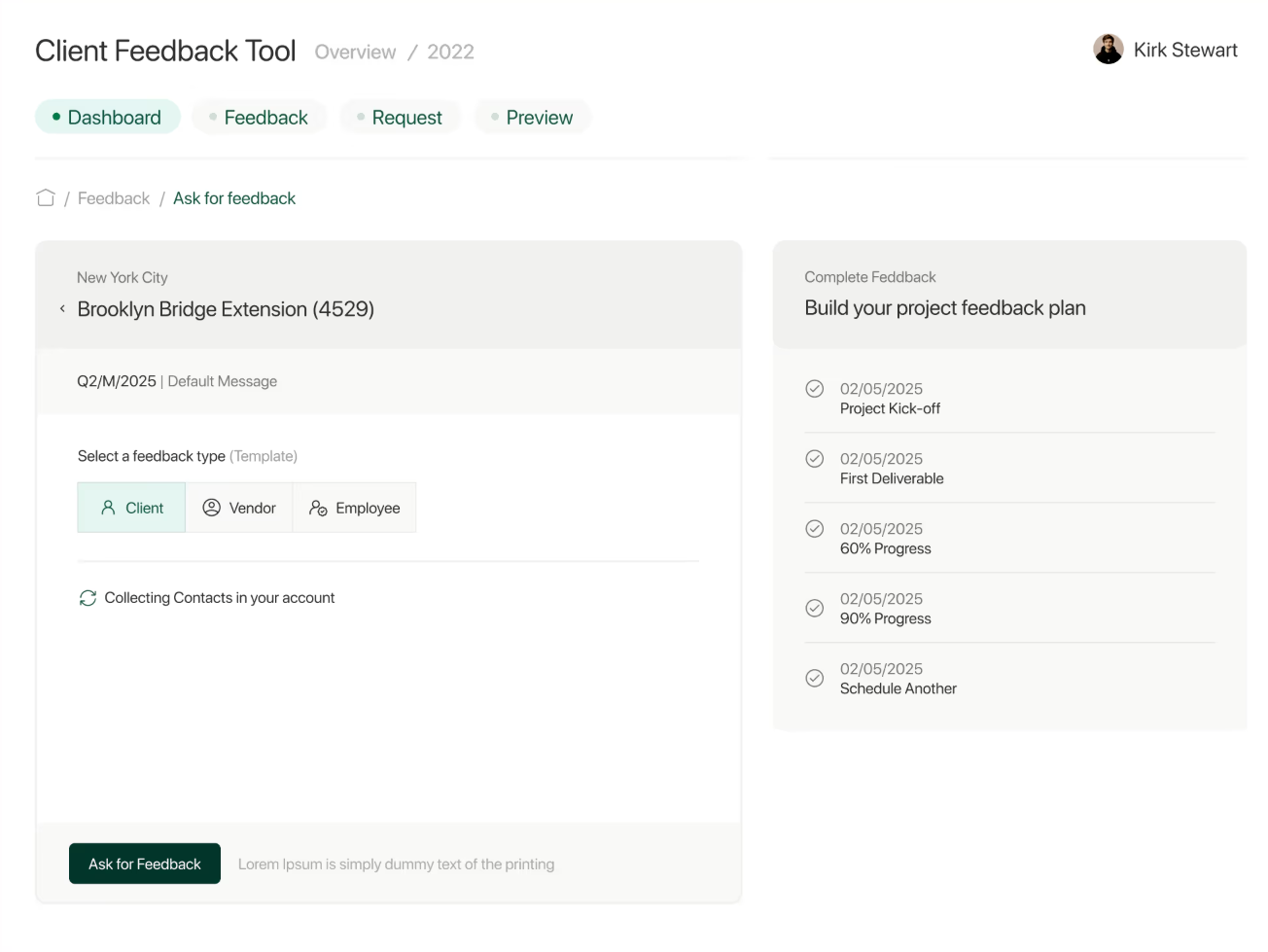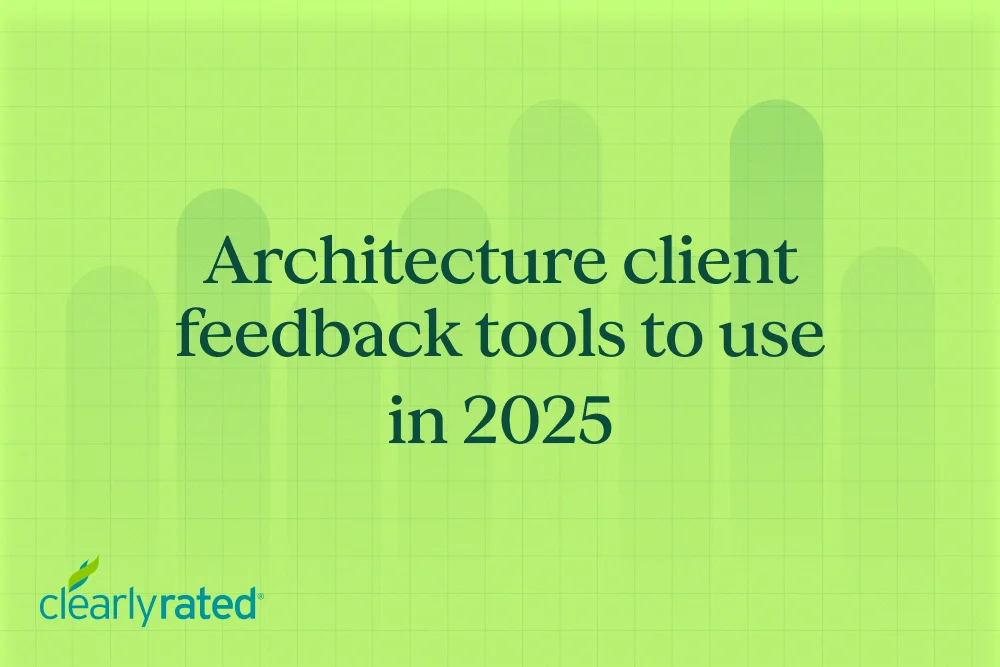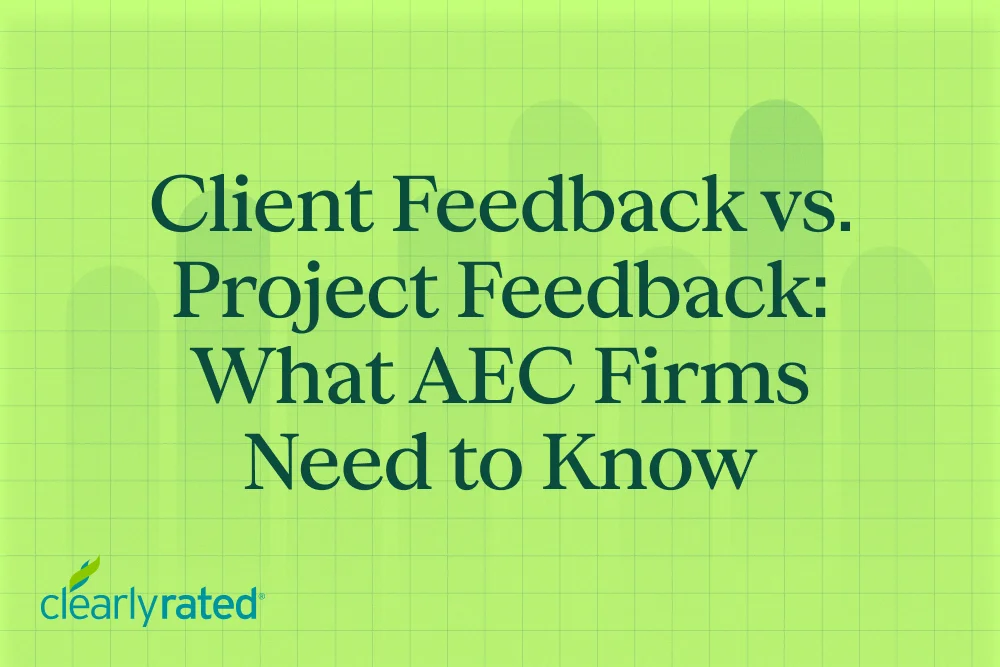How to Capture Post-Construction Feedback That Actually Gets Replies

- Waiting until project completion helps uncover the real issues clients experience once they occupy the space.
- Collecting feedback during close-out gives teams insight into delivery gaps, communication issues, and warranty risks.
- With milestone-triggered surveys and real-time dashboards, teams can act quickly and avoid repeat problems.
- Firms using this approach see 15% higher margins and gain $1.8M in referrals by acting on feedback.
A construction project may be marked complete on paper, but that doesn’t mean your work is truly finished. In fact, this is usually when hidden problems, missed details, or overlooked issues come up. Sometimes it's about warranty, sometimes it's design choices they regret mentioning too late, or sometimes it’s how your team handled communication near the end.
Many firms walk away after the final payment, assuming silence means satisfaction. But without asking directly, you won’t know how the client actually experienced the process. To build loyalty and repeat business, you need real input on what worked and what didn’t.
Our 2025 Benchmarks, Insights, and Trends: Client Experience in the AEC Industry report found that 78% of buyers say a seamless experience influences their decision when selecting a firm. Another 68% say strong communication and relationship quality matter as much as technical skills. That means solid delivery alone isn’t enough if the experience around it feels disconnected or rushed.
In this article, we’ll talk about why post-construction client feedback matters, where most firms go wrong when trying to collect it, and how you can gather better insights that actually get your clients to reply.
What Is Post-Construction/Close-Out Feedback?
Post-construction feedback refers to structured input gathered from clients after the final handover of a project. This includes their experience with how the project was completed, the communication during the final phases, and whether the deliverables matched what was promised or expected. It focuses specifically on the close-out phase, when the construction work is complete but the client relationship still needs attention.
Here’s what post-construction client feedback typically covers once the project is marked complete:
- Quality of workmanship and whether it matched expectations
- Handover experience and how well the final deliverables were communicated
- Warranty process and responsiveness to post-handover issues
- Operational performance of the delivered structure in real-world use
- Client experience during final punch-list discussions and close-out tasks
- Overall satisfaction with project communication and end results
Why Post-Construction Feedback Matters
Let’s explore why post-construction client feedback plays a central role in improving how you deliver future projects, retain clients, and strengthen your market credibility.
Latent issues show up late
You might think the client is satisfied once the final walkthrough is complete and the handover files are signed. But in reality, that’s when unresolved details, delayed concerns, and early defects begin to surface. Clients only start using the space once you leave the site, and that’s when operational problems, warranty requests, or finish-related complaints often come up.
You can use post-construction client feedback to spot these issues early and avoid surprises later. This also allows you to recalibrate your quality control approach and determine whether the defects stem from specific trades, rushed handovers, or oversights in the close-out checklist.
Client decisions form after handover
If clients feel supported in the final weeks, they’re more likely to recommend your firm or engage you again. If the handover process feels rushed or disorganized, that impression can outweigh even high-quality construction.
That’s why post-handover feedback in AEC firms often offers more valuable insights than mid-construction check-ins. By this stage, clients have a complete perspective on communication, responsiveness, and how closely the outcome matched expectations.
Their feedback can determine whether you get a testimonial, a high-quality referral, or repeat work, and it’s often when honest input on team behavior, schedule management, or documentation finally emerges.
Patterns in feedback reduce risk
If three different clients flag similar delays in getting O&M manuals, that’s no longer random. It’s a sign your closing process needs fixing. Firms that collect and analyze post-construction survey data can identify recurring handover gaps and operational issues well before they lead to warranty claims or legal matters.
Clients may also raise technical concerns that weren't captured during walkthroughs. This kind of insight can shape how you manage subcontractors, close out permits, or finalize documentation on future projects.
Close-out feedback improves delivery
Construction issues slow down close-out and create tension during the final stage. By using a clear post-construction feedback tool, you make space for clients to bring this up. This helps you improve closing workflows, standardize handover packs, and even build better project estimate templates based on real input.
You can also compare how your team handled expectations against how clients felt throughout. This provides insight into client expectations, particularly in areas where delivery fell short.
Great feedback builds your reputation
Most firms expect clients to post glowing reviews without ever asking how they felt during the wrap-up. But your most compelling stories usually come from projects where the client felt supported after completion.
With post-construction client feedback, you get real stories, powerful quotes, and case study material that reflects how your firm operates under pressure. You can combine this with content insights, too. For example, Buffer found that accounts posting three-five times weekly see a 12% boost in reach, while those posting 10 times see a 24% lift. Use your feedback data to decide which stories to post, what your clients care about, and what themes get the most traction. These insights help you build a content plan grounded in real experiences.
Additionally, feedback ties back to your overall strategy. Firms that track CX metrics and measure ROI on feedback programs are 94% more likely to grow above average, and 113% more likely to hit above-average profits.
When & How to Collect Post-Construction Feedback
Collecting post-construction client feedback at the right time helps construction firms gain valuable insights from every completed project. The process strengthens relationships, reduces repeat issues, and builds a foundation for better client satisfaction after project completion.
Here’s when and how to gather post-construction client feedback that clients will actually respond to.
When to collect feedback
The best times to collect post-construction client feedback are immediately after the overall completion and then again six to 12 months later. Here’s what each cycle reveals:
- The first round captures immediate impressions about handover, punch-list resolution, and communication.
- The second round reveals how systems perform during actual use, how smoothly warranty support functions, and how lasting the client’s impressions remain.
Who to survey
You want feedback from everyone involved with the project. This includes:
- The client, who can speak about the overall experience and satisfaction
- The client’s operations or facilities team, who interact with the building daily and notice usability or maintenance challenges
- Subcontractors, who can highlight any issues with documentation or expectations
- End users, if applicable, to understand how the space functions in everyday use
Each group brings a unique perspective to the project, offering valuable insights that will help you improve future work.
What questions to ask
Miscommunication remains one of the most costly challenges in construction, with 73% of firms identifying it as the primary cause of rework. To minimize these risks and improve future projects, it’s crucial to ask targeted, relevant questions in your post-project surveys.
Here are the key areas your survey should cover, along with example questions for each:
- Quality of construction and workmanship
- How satisfied are you with the overall quality of the construction?
- Were there any defects or workmanship issues observed after project completion?
- Functionality and delivery accuracy
- Did the final deliverable meet the specifications and expectations set at the start?
- Were there any features or systems that did not function as promised?
- Responsiveness to punch-list items and issue resolution
- How quickly were punch-list items addressed after handover?
- Were any issues resolved to your satisfaction?
- Communication during close-out
- How clear and timely was the communication during project close-out?
- Did you feel adequately informed about next steps and progress?
- Warranty follow-ups
- Have warranty-related concerns been addressed efficiently?
- Did you feel supported during the warranty period?
- Ease of final invoicing and documentation
- Was the invoicing process clear and straightforward?
- Did you receive all necessary documentation promptly and in full?
Which formats to use
To get the most valuable insights, it’s important to use a mix of feedback formats tailored to your clients and project context. For example:
- Online surveys are ideal for gathering structured data and are convenient on mobile devices. Interviews allow clients to share detailed experiences in their own words.
- In-person walk-throughs give your team a firsthand understanding of any issues clients face in the built environment.
Combining these methods provides a more comprehensive picture of client satisfaction.
How ClearlyRated Helps with Post-Construction Feedback
Most AEC firms collect feedback, but very few do it when it actually influences the next project. Our Client Savvy platform helps structure this process effectively by turning feedback into actionable insights.
Here’s how we support your post-construction strategy through features that simplify client experience management.
1. Send surveys at the right time

We give AEC firms like yours the ability to capture feedback at the right moments, not just at handover. You can send milestone-based surveys that trigger automatically when key stages close, like after punch-list resolution or warranty phase check-ins. Instead of waiting for issues to pile up, your team receives feedback while the experience is still fresh in the client’s mind.
Our platform also includes survey templates explicitly built for AEC firms, with questions that are short but targeted. You don’t need to waste time writing custom questions or chasing teams to follow up. The templates cover topics like documentation quality, issue resolution, communication effectiveness, and delivery accuracy, all designed to surface client sentiment quickly.
2. Offer real-time dashboards to spot issues early

Our platform also comes with a real-time dashboard where you can see feedback across both client and project levels. Project managers can drill into response categories like handover experience, responsiveness, or documentation gaps, and act before small issues become repeat problems.
You don’t need to run separate reports or wait for manual updates, as everything updates as feedback comes in.
3. Actionable follow-ups to close the loop
When clients raise concerns, the platform flags those responses and alerts the right people. Each task gets tracked, so it’s always clear who is responsible for follow-up.
You can identify which clients are still awaiting a response and where delays in follow-up may affect the next engagement.
4. Benchmarking across projects and firms
Firms that run feedback programs consistently often see their net promoter score (NPS) rise by an average of 17 points. Our benchmarking tools let you compare your project results against industry peers and past performance. Weekly and monthly reports are generated automatically, giving leadership a clear view.
Every piece of feedback is tagged by client, project, manager, and business unit, making it easy to sort, track, and respond. You can filter results by project type, delivery stage, or stakeholder group to identify areas for improvement. With thousands of report combinations in both visual and table formats, your team can move quickly from data to decisions.
We bring all of this into one platform, so your team can improve client experience with less effort and more confidence.
Measuring the Impact/ROI of Post-Construction Feedback
Most AEC firms already collect some form of client feedback during active phases of the project. You can measure the value of this feedback by tracking specific results that connect directly to project performance.
These include:
- Satisfaction scores
- Repeat business
- Number and severity of warranty issues
- Testimonial rates
- Defect claims
- Legal escalations
Each of these tells a story about how your firm closes work and handles relationships.
McDonald York Building Company proves this in practice. After setting up consistent feedback loops using surveys and internal discussions, the firm collected 278 survey responses in its second year. That effort led to a 15% rise in gross profit margin. Their leadership also used the feedback to open honest conversations with clients and improve trust.
You can track CX metrics such as complaints, defect claims, and testimonials using the right post-construction feedback tool. Companies using our platform uncovered 4x more pain points compared to standard NPS surveys. One firm even retained 83% of at-risk clients just by closing the loop quickly. Additionally, another $1.8 million in referrals was unlocked by reaching out to promoters.
When you collect structured post-project feedback, AEC clients actually respond to, the results speak for themselves.
Implementation Roadmap
Collecting meaningful post-construction feedback requires a clear plan that fits naturally into your existing project workflows. Taking small, deliberate steps helps your team adopt this process without overwhelming anyone.
Below is a practical approach to start and expand your feedback program effectively.
Step 1: Pilot and collect feedback
Begin by piloting a close-out feedback survey on one completed project. Carefully define the questions to focus on specific issues like warranty problems, communication, and overall satisfaction. Collect feedback promptly so the experience remains fresh in clients’ minds.
After gathering responses, hold a review meeting with all relevant stakeholders to discuss findings and decide what actions to take. Implement the agreed improvements on that project and then repeat the process on additional projects, gradually expanding the program across your portfolio.
Step 2: Define roles and assign responsibilities
Assign clear roles and responsibilities within your team. Identify who will send surveys to clients, who will analyze the responses in detail, and who will take action on flagged issues. This clarity removes confusion and speeds up response times.
Make sure the people responsible for follow-up know when and how to contact clients to close the feedback loop.
Step 3: Integrate feedback tools with project systems
Integrate your feedback platform with project management systems and close-out documentation tools. For instance, surveys can automatically trigger when a BIM model reaches a review stage or a milestone closes in Procore.
These connections reduce manual tasks, prevent errors, and improve response rates by sending surveys at the right moments. Linking satisfaction data directly to project milestones creates stronger insights that teams can use immediately to improve processes and client relationships.
Build Stronger Client Relationships Beyond Project Completion
Post-construction feedback plays a direct role in defining client satisfaction, project quality, and future business growth. Many AEC firms overlook this phase, missing valuable insights that could prevent repeat issues or client dissatisfaction.
A simple question every leader should ask is, “What do we fail to learn because we never ask after handover?” That single reflection reveals how critical feedback collection truly is.
Our Client Savvy platform gives firms an easy, organized way to collect, review, and act on client responses throughout project close-out and warranty stages. With real-time reporting, benchmarking, and built-in alerts, your team can turn client sentiment into measurable improvements that protect your reputation and strengthen loyalty.
Get started today and see how capturing honest client feedback after construction helps your firm improve every project.
FAQs
How long after project completion is optimal to collect feedback (immediately vs warranty period)?
The best approach is to collect feedback immediately after project completion and again during the warranty period. We allow firms to schedule both, capturing fresh impressions and long-term satisfaction for balanced insights.
How to use feedback data to change processes (not just collect data)?
Analyze feedback trends to identify recurring issues, and then share findings with project teams to adjust workflows and improve quality. Use these insights to train staff and update standards, turning client comments into actionable process improvements.
What specific concrete improvements or insights have firms discovered only after collecting post-construction feedback?
Many firms using our platform have discovered issues like inconsistent site handovers, communication gaps, or unclear warranty follow-ups. Acting on this feedback led to better close-out documentation, clearer communication protocols, and higher repeat client engagement rates.
How to ensure clients will respond, and what are the best survey designs and incentives?
Keep surveys short, clear, and focused on relevant topics, and send them at key project milestones. Also, offer small incentives like gift cards or future service discounts to motivate responses and demonstrate appreciation for client time.
FAQs







%5B1%5D.webp)






.png)











_%20The%20Ultimate%20Guide.png)





.png)




















%20in%20the%20Workplace.png)










.png)

%20and%20how%20can%20you%20increase%20it.png)
_%20A%20Step-by-Step%20Guide.png)

.png)
.png)




_.png)



%20in%202028.png)


_%20The%20Ultimate%20Guide%20(2024).png)












